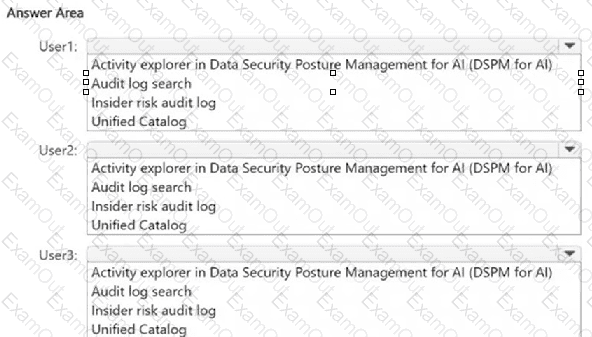You have a Microsoft 365 E5 subscription.
You need to prevent users from uploading data loss prevention (DLP)-protected documents to the following third-party websites:
● web1.contoso.com
● web2.contoso.com
The solution must minimize administrative effort.
To what should you set the Service domains setting for Endpoint DLP?
You have a Microsoft 365 subscription.
Users have devices that run Windows 11.
You plan to create a Microsoft Purview insider risk management policy that will detect when a user performs the following actions:
● Deletes files that contain a sensitive information type (SIT) from their device
● Copies files that contain a SIT to a USB drive
● Prints files that contain a SIT
You need to prepare the environment to support the policy.
What should you do?
HOTSPOT
You have a Microsoft 365 E5 subscription. The subscription contains devices that are onboarded to Microsoft Purview and configured as shown in the following table.

The subscription contains the users shown in the following table.

You need to review the activities.
What should you use for each user? To answer, select the appropriate options in the answer area.
NOTE: Each correct selection is worth one point.

You have a Microsoft 365 subscription.
You create a new trainable classifier.
You need to train the classifier.
Which source can you use to train the classifier?
You have a Microsoft 365 E5 subscription.
You need to create static retention policies for the following locations:
● Teams chats
● Exchange email
● SharePoint sites
● Microsoft 365 Groups
● Teams channel messages
What is the minimum number of retention policies required?
You have a Microsoft 365 E5 subscription that uses Microsoft Purview.
You create a communication compliance policy named Policy1 and select Detect Microsoft Copilot interactions.
Which two trainable classifiers will be added to Policy1 automatically? Each correct answer presents part of the solution.
NOTE: Each correct selection is worth one point.
You have a Microsoft 365 subscription.
You have a user named User1 Several users have full access to the mailbox of User1.
Some email messages sent to User 1 appeal to have been read and deleted before the user viewed them
When you search the audit log in the Microsoft Purview portal to identify who signed in to the mailbox of User l. the results are blank.
You need to ensure that you can view future sign-ins to the mailbox of User1.
Solution: You run the Set-AuditConfig -Workload Exchange command.
Does that meet the goal?
You have a Microsoft 365 E5 subscription.
You create a data loss prevention (DLP) policy and select.
Use Notifications to inform your users and help educate them on the proper use of sensitive info.
Which apps will show the policy tip?
You have a Microsoft 365 E5 subscription that contains a Microsoft SharePoint Online site named Site1.
You need to implement Microsoft Purview data lifecycle management.
What should you create first?
You need to meet the retention requirement for the users' Microsoft 365 data.
What is the minimum number of retention policies required to achieve the goal?



